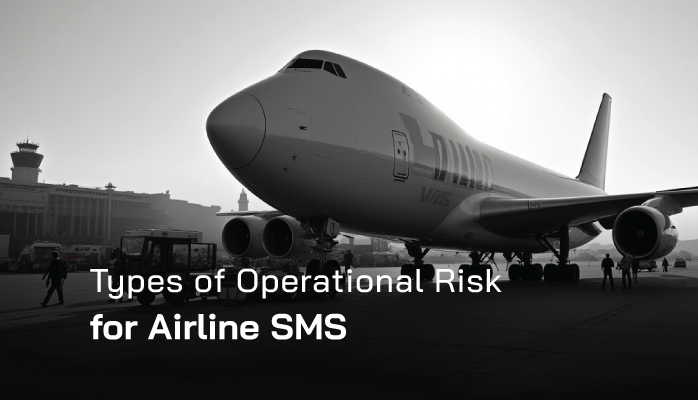What Is Operational Risk for Airline SMS

Operation risk is a primary concern of airline safety management systems (SMS). Just as in traditional safety programs, modern SMS implementations will revolve around identifying hazards and controlling these safety events.
In a formal aviation SMS implementation, there are two inter-connected components:
- Safety risk management (SRM); and
- Safety assurance (SA).
These two risk management components remain critical for airlines to identify hazards and mitigate credible risk scenarios to prevent unwanted hazard-related consequences. Operational risk in aviation SMS is primarily analyzed in:
- Reactive risk management activities; and
- Proactive risk management activities.
Related Aviation SMS Risk Management Articles
- Difference Between Reactive, Predictive and Proactive Risk Management in Aviation SMS
- How to Practice Reactive, Proactive, and Predictive Risk Management in Aviation SMS
- Going From Reactive to Predictive Risk Management in Aviation SMS
Four Identified Categories for Operational Risk at Airlines

We can break down operational risk for airlines and similar service providers into the following categories:
- Loss of Control in Flight (LOC-I);
- Runway Safety;
- Fatigue Risk Management; and
- Controlled Flight into Terrain (CFIT).
Breaking down your system's operational risk profile into these four categories will help categorize risk and focus resources on mitigating the likelihood and/or severity of occurrences in that category. In general, the four types of control measures used for these related mitigation efforts are:
- Technology;
- Aviation safety training;
- Awareness (i.e., hazard identification); and
- Compliance.
Related Articles on Aviation SMS Control Measures
- How to Monitor the Effectiveness of Control Measures
- Difference Between Hazards, Risks & Control Measures in Aviation SMS
- How to Evaluate and Justify a Risk Control in Aviation SMS
Here are the 4 types of operational risk for airline SMS.
1 - Loss of Control in Flight (LOC-I)
Fortunately, loss of control in flight is relatively rare occurrence in aviation SMS. Of all documented accidents from 2012-2016, this type of risk accounted for only 8% of all accidents.
Unfortunately, loss of control is generally a severe type of risk as it usually results in egregious damages. Accordingly, 90% of LOC-I accidents resulted in fatalities. Some ways to help reduce the likelihood of these risks happening are:
- Understanding how environmental factors affect flight control;
- Reviewing historical occurrences in the airline service provider industry of flights that feature loss of control;
- Flight recovery training;
- Understanding most common hazards (dangerous conditions) that lead to loss of control; and
- Understanding the threats and root causes that eventually result in loss of control.
Mitigating LOC-I occurrences will only marginally reduce the total number of aircraft accidents, but it can significantly reduce the overall number of flight accident fatalities. The best types of risk controls should focus slightly more on mitigating damages, as the likelihood of LOC-I incidents is already fairly low.
2 - Runway Safety
Runway safety incidents are the “annoying rock in the shoe” of aviation SMS. The following kinds of occurrences have historically (and currently) plagued airlines and airports:
- Runway incursions and excursions;
- Runway overshoot/undershoots;
- Hard landings; and
- Tail strikes.
Runway safety incidents are the exact opposite of LOC-I. For example, in 2016, runway excursions accounted for a whopping 19% of accidents – the most common type of accident by far. However, only 6% of these types of accidents resulted in fatalities in the 2012-2016 period.
Situational awareness will play the biggest role in preventing runway safety incidents. The best mitigation efforts will focus slightly more on reducing the likelihood of runway safety incidents, as the relative severity of runway incidents is fairly low.
3 - Fatigue Risk Management

Flight crew and cabin crew fatigue is ubiquitously considered as a hazard that will impact general safety function. By “general safety function,” we are talking about the wide-ranging degradation of human ability to:
- Practice safety behavior; and
- To respond to safety incidents.
This is especially true in terms of how fatigue affects:
- Situational awareness;
- Ability to communicate;
- Mission focus; and
- Energy to follow procedures (i.e. fatigue leads to complacency).
Obviously, humans cannot go without sleep, and therefore fatigue will never go away. There are two approaches to managing fatigue risks as recommended by ICAO Standards and Recommended Practices (SARPs):
- Prescriptive fatigue management: operations remain within prescribed limits (by the regulator) for flight time, duty periods, and rest periods; and
- Fatigue Risk Management System: operators use an FRMS system specifically designed to identify and manage fatigue as it arises during operations.
FRMS allows for more flexibility than prescriptive operations but does require more resources, work, and responsibility on the part of operators.
Related Articles on Fatigue Risk Management in Aviation SMS
- 3 Ways for Dealing With Fatigue Risk Management in Aviation SMS
- How to Incorporate Fatigue Risk Management Into Aviation SMS
- How to Best Monitor Fatigue in Your Aviation SMS
4 - Controlled Flight Into Terrain (CFIT)
Controlled flight into terrain (CFIT) probably represents the most severe type of operational risk for airline service providers. This is due to the extremely high fatality rate and hull loss rates when these safety incidents occur.
For example, there were 67 CFIT accidents between 2005 and 2014, which caused 1346 fatalities. This is an average fatality rate of 20 persons every time this incident occurs. Moreover, in this same period of time, those accidents featured a 99% hull loss rate (i.e., 66/67 aircraft featured hull loss).
The number one contributor to CFIT is human performance deficiencies. IATA found that in all CFIT incidents (100%) in the 2005-2014 time period, undesirable behaviors contributed to the accident – specifically, situational awareness.
Final Thought: Future and Emerging Operational Risks
Emerging risks that will increasingly need to be considered in the conversation of operational risk for aviation service providers are:
- Unmanned Aircraft Systems (i.e., drones);
- Cybersecurity; and
- Concerns over conflict zones as tensions rise in many places worldwide.
Here are some more resources that will help understand operational risk:
Last updated August 2025.









